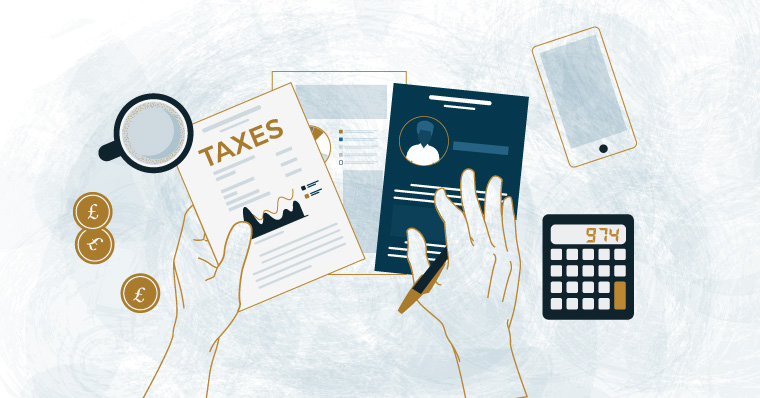
While HMRC does its best to give you the correct tax code, it issues millions of codes each year – so there’s room for error. If you’re on the wrong tax code, it’s your responsibility to report it and have it corrected. There are a number of factors that can influence your tax code, with changes in retirement and savings policies largely responsible.
How to check your tax code
Before you are able to see if you’re on the wrong tax code, you’ll need to be able to read and understand it. Let’s take a look at this in more detail.
Numbers
The numbers represent your Personal Allowance figure. This is how much you can earn before you need to start paying income tax. For example, someone with a tax code of 1257L can earn £12,570 before having to pay tax.
An easy way to work this out is to put a “£” in front of the numbers and a “0” after them.
The Personal Allowance figure usually changes on 6 April, at the start of each financial year, so it’s a good idea to look out for this.
Letters
The letters in your tax code follow the number and all have their own meaning:
|
Letters |
Meaning |
Reasoning |
|
BR |
Taxed at the basic rate of 20%. |
Applies to individuals with more than one income stream. |
|
D0 |
Taxed at the higher rate of 40%. |
When you have one income stream at a normal tax code and a second salary pushes you over into the higher rate tax band. |
|
D1 |
Income is taxed at the additional rate of 45%. |
You earn over £150,000 per year and have a pension or other income source. |
|
L |
You receive the full Personal Allowance. |
Your tax situation is standard. |
|
M |
You’ve received a transfer of 10% of your partner’s Personal Allowance. |
Your partner has not used up their Personal Allowance entitlement. |
|
N |
You’ve transferred 10% of your Personal Allowance to your partner. |
You have not used your full Personal Allowance amount. |
|
NT |
You’re not paying tax on this income. |
|
|
S |
You pay the Scottish rate of income tax. |
You live and work in Scotland. |
|
C |
You pay the Welsh rate of income tax. |
You live and work in Wales. |
|
T |
Your tax code includes other calculations to work out your Personal Allowance. |
Your tax position is “not settled”. |
Why do I have the tax code OT?
When you’ve been given this tax code, it means that you did not receive a Personal Allowance with this income and all your income is taxed. This could be because:
- Your Personal Allowance has been used up
- You’ve started a new job and your employer does not have all the details yet to give you the correct tax code
How much tax you’ll pay with an OT tax code
The amount of income tax you’ll pay is dependent on how much you earn. Usually, you’ll pay 20% income tax on all your taxable earnings. This will increase to 40% if you are a higher rate taxpayer.
How is your tax-free Personal Allowance calculated?
The Personal Allowance is the amount of income that can be earned tax-free. Whatever income is left after this and any additional allowances have been deducted, will be taxed according to the income tax band you fall into.
|
Band |
Taxable income |
Tax rate |
|
Personal Allowance |
Up to £12,570 |
0% |
|
Basic rate |
£12,571 to £37,700 |
20% |
|
Higher rate |
£37,701 to £150,000 |
40% |
|
Additional rate |
Over £150,000 |
45% |
For the 2021/2022 tax year, the Personal Allowance is set at £12,570. HMRC starts with the basic tax-free allowance and adds or deducts anything that could affect this total. For example, a Personal Savings Allowance and tax-deductible work expenses could increase this amount, while outstanding tax bills and a state pension could decrease it.
Following this calculation, your tax code is given to your pension provider and employer to indicate how much tax should be deducted from your income.
If you’re self-employed
If you’re self-employed, you’ll pay income tax on your profits, not your total income. To work out your profit, you’ll deduct your business expenses from your total income, and this is the amount you’ll pay tax on. The same tax bands and rates that apply to someone who is employed, will apply to you – see the table above. For example, if your profit is £60,000 for the 2021/22 tax year, you’ll pay:
- No tax on £12,570
- 20% tax on £37,700 (difference between £12,570 and £50,270)
- 40% tax on £10,000 (amount over £50,271)
Tax code beginning with a “K”
If your tax code has a “K” at the beginning, it means that you have income that is not being taxed another way and it’s worth more than your tax-free allowance. This usually happens when:
- You’re paying tax owed from a previous year through your wages or pension
- You’re getting benefits, such as state or company benefits, that you need to pay tax on
Emergency tax codes
Your payslip will have the following codes if you are on an emergency tax code:
- 1257L W1
- 1257L M1
- 1257L X
You’ll usually be given this code if you’ve started a new job, were previously self-employed and are now working for an employer or are receiving company benefits or a State Pension. Emergency tax codes are temporary and can be updated by your employer.
Why has my tax code changed?
Any situation where you receive more than one source of income could result in the allocation of the incorrect tax code. This could include:
- State and private pension plans
- Having more than one job at the same time
- Short-term contracts
A rise or fall in income could also result in a change of tax code. The most common reason for a change in tax code is when employees receive benefits from their employers.
How to change my tax code
Should you discover that you’re on the wrong tax code, it is possible to rectify it. You can correct it online, over the phone or through an accountant.
Changing your tax code online
You’ll need to have or create an account on the HMRC website which will allow you to check your tax code, see if your tax code has changed, inform HMRC about any changes that affect your tax code and get an estimate of how much tax you’ll pay for the tax year.
Changing your tax code over the phone
To change your tax code over the phone you must call the HMRC on 0300 200 3300. They are open from Monday to Friday from 8:00 to 18:00. Make sure to have your National Insurance number with you when you call.
Use an accountant to change your tax code
The benefit of going this route is that an accountant can make sure that you are tax compliant and haven’t paid too much or too little tax. What’s more, if you’re due a tax refund, they can make sure that it’s done swiftly and tax-efficiently.
Use a tax return calculator to work out your tax rebate
A tax return calculator is a useful tool that helps you check if you’re due a refund from HMRC. Simply fill in your details and you’ll receive an estimate of the amount that’s due. If you’re owed a refund, you can start your claim.
You can submit your claim yourself or have an accountant do it for you. The benefit of using an accountant is that they’ll deal with all the admin and ensure that you get your full tax refund sooner and hassle-free.
